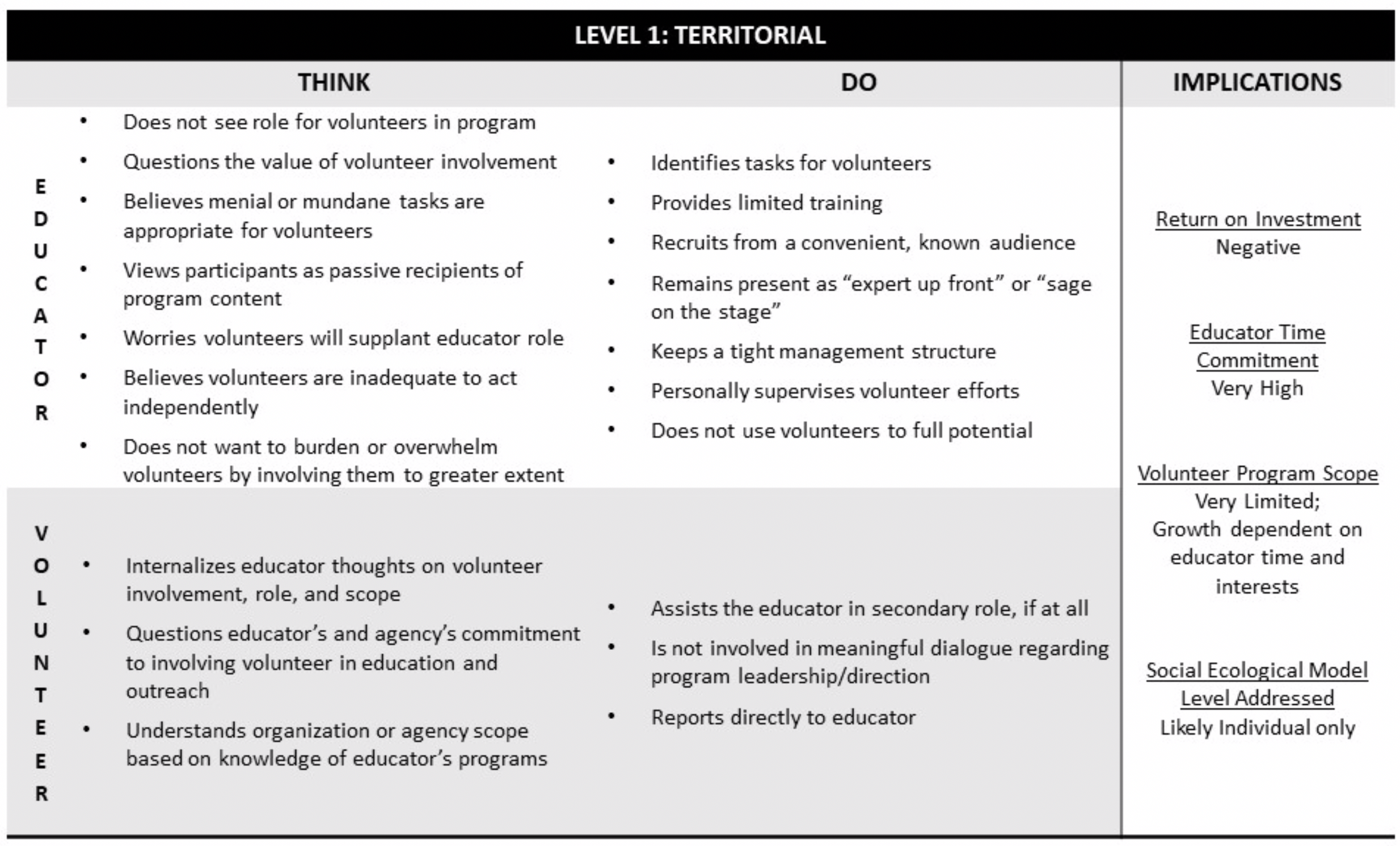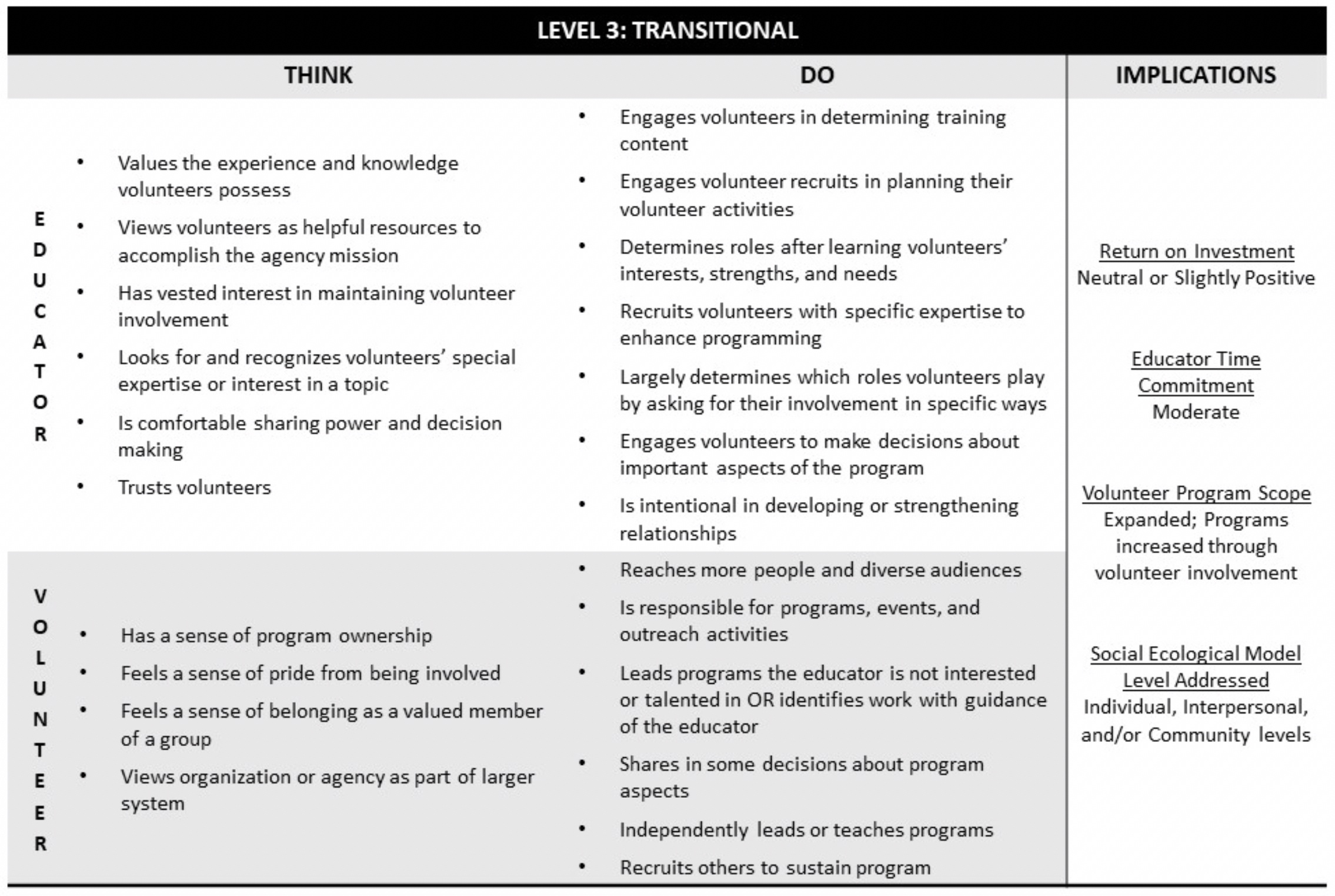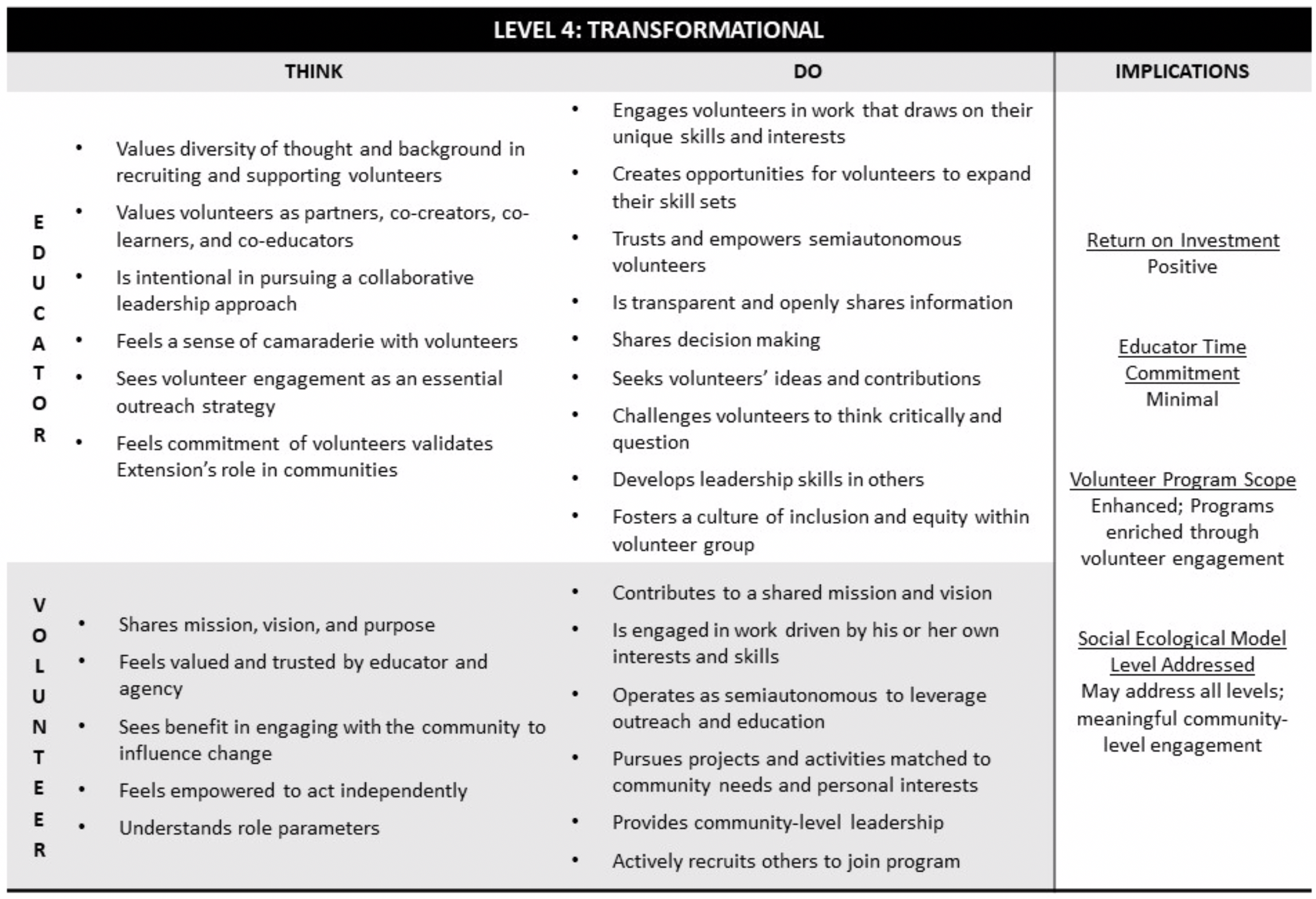 |
August 2020
|
August 2020 // Volume 58 // Number 4 // Tools of the Trade // v58-4tt3
From Territorial to Transformational: A New Framework for Master Volunteer Engagement
Abstract
Meaningful volunteer engagement depends on the Extension professional's volunteer management philosophy, training, and organizational support for using volunteers. Volunteer development and leadership development are typically absent from management-focused volunteer models used in Extension. Professional development of the Extension professional, beyond discrete management tasks, is lacking but is needed for authentic volunteer engagement through master volunteer programs. A volunteer engagement framework is described to guide a shift from volunteer management to engagement, including use of principles of the community-based participatory approach. The volunteer engagement framework can help professionals identify and self-assess the skill set needed for authentic and sustained volunteer involvement in support of Extension.
Volunteers are as fundamental to Extension work as our reliance on research-based information. Volunteers have been critical in Extension's delivery strategy since inception, but engagement levels vary greatly, primarily dependent on factors external to volunteers, such as the Extension professional's volunteer management philosophy, training, and organizational support (Boyd, 2004; Strauss & Rager, 2017). Just as Extension programming evolves to meet local needs, volunteer management strategies must change to address shifting priorities and renewed focus on community-based approaches, particularly for health outreach (Washburn, 2017). After reviewing volunteer management models commonly used in Extension work, we present a new volunteer engagement framework (VEF) we developed to guide Extension personnel as they involve volunteers as equal partners. This framework is especially relevant as master volunteers are developed to extend reach in health and wellness efforts. Extension professionals can use this framework to assess their own readiness for expanded volunteer engagement.
Background and Rationale
Introduced nearly 40 years ago, ISOTURE (Identification, Selection, Orientation, Training, Utilization, Recognition, Evaluation) provided the foundation for volunteer management professionals and is the model from which later Extension-focused volunteer management models evolved (Boyce, 1971; Safrit & Schmiesing, 2011). Boyce (1971) asserted that volunteer management involves leadership development and was the first to focus on growth and development of the volunteer leader as an aspect of the volunteer manager's role. Volunteer leadership development is less explicit in other volunteer management models, such as GEMS (Generate, Educate, Mobilize, and Sustain) and LOOP (Locating, Orienting, Operating, Perpetuating) (Culp, 2012; Penrod, 1991). These draw from the human resources management (HRM) model of volunteer management used by nonprofits to shape best practices. HRM focuses on core job functions performed by volunteers, lacking emphasis on volunteer development (Einolf, 2018). Although components of these models make practical sense, they fail to acknowledge the critical relational nature of volunteer management and the importance of the volunteer manager's role in optimizing volunteer development.
A further deficiency of existing models is absence of attention to professional development, specifically with regard to the attitudes and leadership behaviors of the local volunteer manager (Extension agent). Of 10 volunteer management models reviewed by Safrit and Schmiesing (2011), only three explicitly included professionalism and development of the volunteer manager as key components. Boyd (2004) highlighted Extension professionals' deficiencies in coordinating volunteers and concerns about insufficient training. Given the absence of models emphasizing the important role of volunteer managers, and continued reliance on HRM approaches to volunteer management in Extension, new tools are needed to guide Extension professionals in working with volunteers. Addressing this need is particularly important as the Extension system considers engaging master volunteers to improve health for individuals and communities, a relatively new area for using master volunteers.
Management of all volunteers, especially master volunteers, requires delicately balancing the bureaucracy inherent in the land-grant system and the need for local autonomy (Einolf, 2018). Master volunteers can extend Extension reach by serving as a paraprofessional-type community workforce if applicable opportunities are provided (Strauss & Rager, 2017). However, existing volunteer management models are just that—management of volunteer efforts, often oversimplified in checklist form, overlooking the impact of the supervising Extension professional's attitudes and leadership behaviors on the volunteer development process. Objective management measures fail to acknowledge the unique nature of Cooperative Extension's work in communities, with clientele and volunteers, where "management" may stand in the way of "engagement."
Existing management models also lack a community-based participatory approach (CBPA) critical for sustained success of volunteer efforts to improve health (Israel, Eng, Schulz, & Parker, 2013). CBPA principles applied to volunteer leadership include engaging volunteers as equal partners, sharing decision making, valuing authentic engagement, and balancing the organization's needs with volunteers' interests and developmental needs. Application of such principles contrasts with current volunteer management practices of predetermining volunteer roles before volunteers are recruited and creating generic position descriptions based on organizational needs without involving volunteers in role cocreation.
VEF
Implementing Extension master volunteer programs for community health calls for new levels of volunteer engagement. The national movement toward adoption of such programs suggests that new tools are needed to guide Extension professionals in their work with these groups. We developed the VEF to address this need, and it can be used by Extension professionals to self-evaluate where they fall on a volunteer engagement continuum and identify behaviors needed to progress. Informed by CBPA, community engagement principles, and applied experiences with master volunteer programs, the VEF is rooted in transformative education and transformational leadership theories (Bass & Riggio, 2006; Boyd & Myers, 1988; Israel et al., 2013; McCloskey et al., 2011). The tool was reviewed by a panel of state and county Extension professionals in two states and refined according to their feedback.
The VEF presents a continuum of volunteer engagement described in four levels: territorial (Figure 1), targeted (Figure 2), transitional (Figure 3), and transformational (Figure 4). Each level includes educator and volunteer perceptions ("Think") and actions ("Do"), along with implications related to return on investment, time commitment, program scope, and probable social ecological model level addressed.
Figure 1.
Volunteer Engagement Framework Level 1: Territorial

Figure 2.
Volunteer Engagement Framework Level 2: Targeted

Figure 3.
Volunteer Engagement Framework Level 3: Transitional

Figure 4.
Volunteer Engagement Framework Level 4: Transformational

Implications and Conclusion
Opportunities abound for volunteer involvement in Extension (Boyd, 2004). Meaningful master volunteer engagement begins with readiness of Extension professionals to work with master volunteers in shared planning and implementation of programming. The VEF provides opportunity for Extension professionals to self-evaluate attitudes and attributes contributing to shared leadership with master volunteers. Although not meant to address the broad gap in the literature between volunteer administration and volunteer engagement, the VEF begins movement toward identification and application of a skill set required for effective, efficient, and long-lasting master volunteer involvement.
For Cooperative Extension to remain relevant and compete in an era where information is always available at one's fingertips, it has to be present where people live and work. This imperative is hard to reconcile with Extension's shrinking resources and community footprints. Effectively mobilizing and using master volunteers can leverage Extension outreach and education, allow Extension to reach new audiences, and allow Extension professionals to focus on higher priority issues and strategic visioning. The intent of the VEF is to change the question from "what do I do with my volunteers?" to "what can my volunteers do?"
References
Bass, B., & Riggio, R. (2006). Transformational leadership. New York, NY: Psychology Press.
Boyce, M. (1971). A systematic approach to leadership development. Washington, DC: U.S. Department of Agriculture, Extension Service. (ERIC Document Reproduction Service No. ED 065 763).
Boyd, B. (2004). Extension agents as administrators of volunteers: Competencies needed for the future. Journal of Extension, 42(2), Article 2FEA4. Available at: https://www.joe.org/joe/2004april/a4.php
Boyd, R. D., & Myers, J. G. (1988). Transformative education. International Journal of Lifelong Education, 7(4), 261–284. doi:10.1080/0260137880070403
Culp, K., III. (2012). Overview of the GEMS model of volunteer administration (generate, educate, mobilize and sustain). Journal of Extension, 50(6), Article v50-6tt10. Available at: https://www.joe.org/joe/2012december/tt10.php
Einolf, C. (2018). Evidence-based volunteer management: A review of the literature. Voluntary Sector Review, 9(2), 153–176.
Israel, B., Eng, E., Schulz, A., & Parker, E. (2013). Introduction to methods for community-based participatory research for health. In B. Israel, E. Eng, A. Schulz, & E. Parker (Eds.), Methods in community-based participatory research for health (2nd ed., pp. 3–37). San Francisco, CA: Jossey-Bass.
McCloskey, D. J., McDonald, M. A., Cook, J., Heurtin-Roberts, S., Updegrove, S., Sampson, S., . . . Eder, M. (2011). Community engagement: Definitions and organizing concepts from the literature. In Principles of community engagement (2nd ed., pp. 3–41; NIH Publication No. 11-7782). Retrieved from https://www.atsdr.cdc.gov/communityengagement/pdf/PCE_Report_508_FINAL.pdf
Penrod, K. M. (1991). Leadership involving volunteers. Journal of Extension, 29(4), Article 4FEA2. Available at: https://www.joe.org/joe/1991winter/a2.php
Safrit, R. D., & Schmiesing, R. (2011). Volunteer models and management. In T. D. Connors (Ed.), The volunteer management handbook (2nd ed., pp. 3–30). New York, NY: Wiley and Sons.
Strauss, A. L., & Rager, A. (2017). Master volunteer life cycle: A wide angle lens on the volunteer experience. Journal of Extension, 55(4), Article v55-4tt7. Available at: https://www.joe.org/joe/2017august/tt7.php
Washburn, L. T. (2017). Engagement of health volunteers: A promising approach for meeting community needs. Journal of Extension, 55(3), Article v55-3comm1. Available at: https://www.joe.org/joe/2017june/comm1.php




